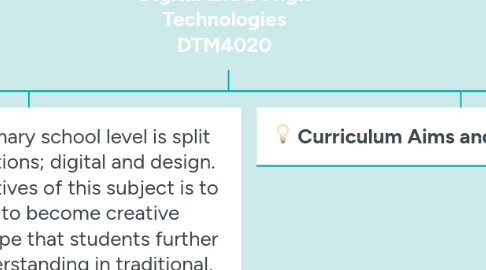
1. Subjects.
1.1. In Primary school students are taught two forms of technology; digital and design. Design technologies is when students use design thinking to generate and produce designed solutions for authentic needs and opportunities. Digital technologies is when students use computational thinking and information systems to design and implement digital solutions.
2. Key Concepts and Ideas. The over arching idea within this subject is; creating preferred futures this allows students to consider how solutions that are created now can be effecitvley used in the future. Other ideas include project management andthinking in technologies.
2.1. Project Management; where students develop skills to manage projects that ensures successful completion through planning, organising and monitoring.
2.2. Thinking in technology; Systems thinking- The system where by an organised group of related objects or componenets that work together to form a whole. Design thinking involves the use of strategies for understanding design needs and opportunities, visualising and generating creative and innovative ideas, planning, and analysing and evaluating those ideas that best meet the criteria for success. Computational thinking is a problem-solving method that is applied to create solutions that can be implemented using digital technologies
3. Student diversity
3.1. Meeting diverse needs- The relationship between learning areas, general capabilities and cross curricular priorities allow for teachers to develop programs that are
3.1.1. Teachers refer to the Australian Curriculum learning area content that aligns with their students’ chronological age as the starting point in planning teaching and learning programs. Teachers take account of the range of their students’ current levels of learning, strengths, goals and interests, and personalise learning where necessary through adjustments to the teaching and learning program. Teachers assess students’ progress through the Australian Curriculum in relation to achievement standards. Some students’ progress will be assessed in relation to their individual learning goals.
4. Cross Curricular Priorities
4.1. -Aboriginal and Torres Strait Islander histories and cultures - Asia and Australia's engagement with Asia - Sustainability
5. Design Technology - Content descriptors / Elaborations - Achievement standards
5.1. The Design and technologies curriculum is split into two main strands; knowledge and understanding and process and production skills.
5.1.1. Foundation to Year 6- Knowledge and Understanding; Content descriptors and elaborations
5.1.2. Foundation to Year 6- Process and production skills; Content descriptors and elaborations
5.1.2.1. Achievement Standards
5.1.2.1.1. FOUNDATION TO YEAR 6 Developing skills in the following areas -Engineering principles and systems -Food and fibre production and food specialisations -Materials and technologies specialisations.
6. Band levels
6.1. Foundation to Year 2- DESIGN Learning in Design and Technologies builds on concepts, skills and processes developed in the Early Years Learning Framework, revisiting, strengthening and extending these as needed. DIGITAL Learning in Digital Technologies builds on concepts, skills and processes developed in the Early Years Learning Framework. It focuses on developing foundational skills in computational thinking and an awareness of personal experiences using digital systems.
7. Technology at Primary school level is split into two main sections; digital and design. The aims of objectives of this subject is to allow for students to become creative individuals. It is hope that students further develop their understanding in traditional, contemporary and new innovative ways. The Australian curriculum main aims include; allowing students to investigate, design, plan, create and evaluate solutions to different problems. Encouraging students to make informed and ethical decisions about the role, impact and use of technology in the future.
8. Digital Technology - Content descriptors/ Elaborations - Achievement standards
8.1. The Digital and technologies curriculum is split into two main strands; knowledge and understanding and process and production skills.
8.1.1. Foundation to Year 6- Knowledge and Understanding; content descriptors and elaborations
8.1.1.1. Foundation to Year 6- Process and production skills; Content descriptors and elaborations
